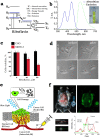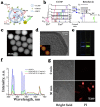Riboflavin photoactivation by upconversion nanoparticles for cancer treatment
- PMID: 27731350
- PMCID: PMC5059683
- DOI: 10.1038/srep35103
Riboflavin photoactivation by upconversion nanoparticles for cancer treatment
Abstract
Riboflavin (Rf) is a vitamin and endogenous photosensitizer capable to generate reactive oxygen species (ROS) under UV-blue irradiation and kill cancer cells, which are characterized by the enhanced uptake of Rf. We confirmed its phototoxicity on human breast adenocarcinoma cells SK-BR-3 preincubated with 30-μM Rf and irradiated with ultraviolet light, and proved that such Rf concentrations (60 μM) are attainable in vivo in tumour site by systemic intravascular injection. In order to extend the Rf photosensitization depth in cancer tissue to 6 mm in depth, we purpose-designed core/shell upconversion nanoparticles (UCNPs, NaYF4:Yb3+:Tm3+/NaYF4) capable to convert 2% of the deeply-penetrating excitation at 975 nm to ultraviolet-blue power. This power was expended to photosensitise Rf and kill SK-BR-3 cells preincubated with UCNPs and Rf, where the UCNP-Rf energy transfer was photon-mediated with ~14% Förster process contribution. SK-BR-3 xenograft regression in mice was observed for 50 days, following the Rf-UCNPs peritumoural injection and near-infrared light photodynamic treatment of the lesions.
Figures



References
-
- Morris H. P. Effects on the genesis and growth of tumors associated with vitamin intake. Annals of the New York Academy of Sciences 49, 119–140, doi: 10.1111/j.1749-6632.1947.tb30939.x (1947). - DOI
-
- Rao P. N. et al.. Elevation of serum riboflavin carrier protein in breast cancer. Cancer Epidemiology Biomarkers & Prevention 8, 985–990 (1999). - PubMed
Publication types
MeSH terms
Substances
LinkOut - more resources
Full Text Sources
Other Literature Sources

